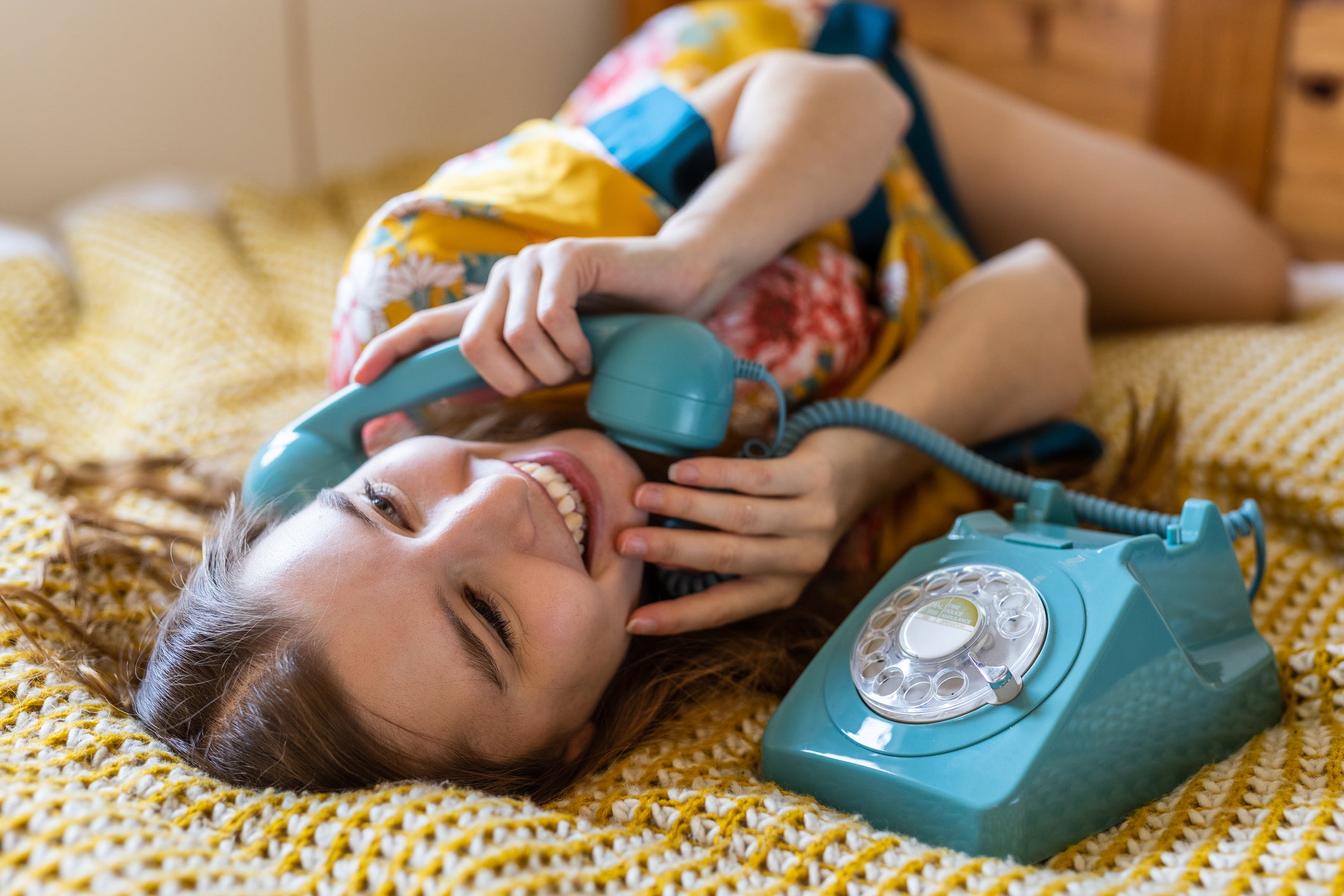Too much screen time? Landline phones offer a lifeline
Like record players and VHS tapes, there seems to be life in the old landlines yet, Hilary Reid spoke to those who are bringing them back into their homes

Your support helps us to tell the story
From reproductive rights to climate change to Big Tech, The Independent is on the ground when the story is developing. Whether it's investigating the financials of Elon Musk's pro-Trump PAC or producing our latest documentary, 'The A Word', which shines a light on the American women fighting for reproductive rights, we know how important it is to parse out the facts from the messaging.
At such a critical moment in US history, we need reporters on the ground. Your donation allows us to keep sending journalists to speak to both sides of the story.
The Independent is trusted by Americans across the entire political spectrum. And unlike many other quality news outlets, we choose not to lock Americans out of our reporting and analysis with paywalls. We believe quality journalism should be available to everyone, paid for by those who can afford it.
Your support makes all the difference.First came the rhinestone-encrusted rotary. Then the cherry-red lips. After that, the cheeseburger.
By last summer, Chanell Karr had amassed a collection of six landline phones. Her most recent, an orange corded model made as a promotional item for the 1986 film “Pretty in Pink,” was purchased in June. Though she only has one of them – a more subdued VTech phone – hooked up, all are in working order.
“During the pandemic I wanted to disconnect from all of the things that distract you on a smartphone,” says Karr, 30, who works in marketing and ticketing at a music venue. “I just wanted to get back to the original analog ways of having a landline.”
Once a kitchen staple, bedside companion and plot device on sitcoms such as Sex and the City and Seinfeld, the landline phone has all but been replaced by its newer, smarter wireless counterpart.
In 2003, more than 90 per cent of respondents to a survey conducted by the CDC in the US said they had an operational landline in their homes. As of June 2021, that number – which includes internet-connected phones and those wired the old-fashioned way (via copper lines running from a home to a local junction box) – had dropped to just over 30 per cent.
But like record players and VHS tapes, landline phones are being embraced by nostalgic fans who say their non-scrollable and non-strollable nature is an antidote to screen fatigue and over-multitasking. The crescent shape of many phones’ receivers, users say, is also a more natural, comfortable fit against a cheek than the planar body of a smartphone. And with a non-cordless device, one must commit more to the act of conversation; the phone call becomes more intentional.
In January, Emily Kennedy, a communications manager in the Canadian public service, started using an old Calamine-lotion-pink rotary phone from her father’s office as a way to detach from her work in social media.
Ironically, it was from Twitter that Kennedy got the idea. When Rachel Syme, a staff writer at The New Yorker, tweeted in January about a landline phone that she had hooked up via Bluetooth, Kennedy was one of many who replied saying that Syme had inspired them to set up one of their own.
Talking on a landline is kind of like going to see a movie in the theatre, versus watching it at home where you have distractions
“Having my old phone as an object in my house is an identity signal that I like a slower pace,” says Kennedy, 38, who lives in Ottawa, Ontario.
Like Syme and many other modern users of analog phones, Kennedy doesn’t have her landline copper wired – so it doesn’t have its own number – but uses a Bluetooth attachment to connect it to her smartphone’s mobile service. (In other words, when she’s connected, she can take a mobile phone call on the landline.)
Matt Jennings has worked at Old Phone Works, a company in Kingston, Ontario, that refurbishes and sells landline phones, since 2011. Now its general manager, Jennings, 35, says that in the past two years, customers’ demand for candy-coloured rotary phones from the 1950s and 1960s has skyrocketed.
“About a year and a half ago, it absolutely exploded,” Jennings says. “Over the past six or seven years, we might get one or two orders for them, and now it’s probably one of our primary sources of revenue.”
Regarding what has motivated the recent desire for landline phones, Jennings says, “It’s a return to basics.” He adds, “You can’t really go anywhere with a corded phone, you’re basically stuck within a 3-foot radius of the base. You can have a real conversation without being distracted.”

Rachel Lahbabi, 37, noticed a similar surge in interest after she started selling landline phones online through her Etsy store, Robert Joyce Vintage, in early 2021. By that October, they had become some of the most viewed products she offered, says Lahbabi, who lives in Charlotte, North Carolina.
“The ones I was putting up were just going so quickly,” she says. “I thought, ‘OK, people are clearly looking for this, so I should really focus on this trend.’”
Pink phones shaped like lips have been particularly popular among her customers, Lahbabi says, as well as models that are clear or neon. Also in demand: Garfield phones.
All of these styles, she adds, “are probably similar to a phone they had when they were younger.”
Across Etsy, there was a 45 per cent increase in searches for Y2K and Nineties phones and a 26 per cent increase in searches for rotary phones in 2021 compared to 2020, says Dayna Isom Johnson, a trend expert at the company.
“Talking on a landline is kind of like going to see a movie in the theatre, versus watching it at home where you have distractions,” says Nicole Wilson, 32, who has two rotary phones at her home in Manhattan: a pink Princess and another model that’s baby blue.
Wilson, a director of sales at Upfluence, an influencer marketing platform, also says that landline phones offer a reprieve from her screen-heavy work. She purchased her first phone in 2019 and started using it after watching a TikTok video that explained how to connect it to her mobile phone using Bluetooth.

While many who have recently acquired landline phones are using them with newer technology, some prefer a more traditional approach.
Janelle Remlinger, 37, got a landline phone for her home in Plymouth, Massachusetts, in December 2020, after a storm disrupted mobile phone service in her area. She wired it to her modem, but when Remlinger lost power for eight days during another storm in October, she began searching for a more reliable connection.
“I’m working on getting an authentic, real, old-school landline piped in through the wires,” Remlinger says.
As appealing as landline phones may be, even their most ardent fans recognise it is basically impossible to use them exclusively.
Alex McConnell, 30, a personal banker at KeyBank in Fort Collins, Colorado, has a Western Electric rotary phone wired to copper lines at his home. On 14 February, he did not celebrate Valentine’s Day, but the 146th anniversary of Alexander Graham Bell submitting the patent application for the telephone.
“I prepared a meal with ‘Bell’ peppers and ‘Graham’ crackers,” McConnell says. “Then I made a circular cake [and] I used blue icing to put the Bell logo on, and the original patent number for the telephone.”
His landline phone is not only more reliable than a mobile phone, he says, but also encourages him to memorise friends’ phone numbers, which he considers a form of intimacy.
“Since I actually have to dial my friend’s phone numbers, I find it really does help me connect them to memory,” McConnell says.
But even he cannot avoid the call of modern life.
“My secret sorrow is that I do have a cellphone.”
This article originally appeared in The New York Times.




Join our commenting forum
Join thought-provoking conversations, follow other Independent readers and see their replies
Comments